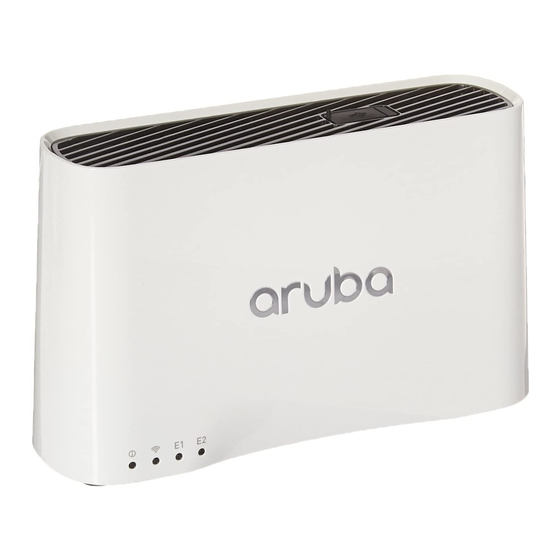
Advertisement
Table of Contents
- 1 Installation Guide
- 2 Package Contents
- 3 Hardware Overview
- 4 System Status
- 5 Console Port
- 6 Ethernet Ports
- 7 Before You Begin
- 8 Identifying Specific Installation Locations
- 9 Access Point Installation
- 10 Verifying Post-Installation Connectivity
- 11 Electrical and Environmental Specifications
- 12 Proper Disposal of Aruba Equipment
- 13 Regulatory Information
- 14 Contact Aruba
- Download this manual
Aruba 203R Series Wireless Access Points
Installation Guide
Aruba 203R Series remote access points (203R and 203RP) are high-performance flex-radio wireless devices for
hospitality and branch deployments.
These access points contain a dual band 802.11ac flex-radio and Ethernet ports to provide secure Wi-Fi. The
wired Ethernet ports located on the back of this access point allow users to connect directly to the device when
linked by an Ethernet cable.
IEEE 802.11a/b/g/n/ac operation as a wireless access point
IEEE 802.11a/b/g/n/ac operation as a wireless air monitor
Compatibility with IEEE 802.3 af PoE-out (E2 port) (Aruba 203RP only)
Central management configuration
Support for selected USB peripherals
Integrated Bluetooth Low Energy (BLE) radio
Package Contents
The following materials are included with this product:
Aruba 203R Series access point
Snap-on back cover
Inform your supplier if there are any incorrect, missing, or damaged parts. If possible, retain the carton, including
the original packing materials. Use these materials to repack and return the unit to the supplier if needed.
Hardware Overview
The following sections outline the hardware components of the 203R Series access point.
Figure 1
AP-203R-IG-02 | August 2017
Aruba 203R Series (front view)
1
Advertisement
Table of Contents

Summarization of Contents
LED Status Indicators
System Status LED
Explains the function of the System Status LED and its various states.
Radio Status LED
Details the meaning of the Radio Status LED and its operating modes.
Network Status LEDs
Network Status (E1) LED
Describes the E1 LED's indication of network activity on the wired port.
Network/PSE Status (E2) LED
Explains the E2 LED's indication of network activity and PoE-out status.
Port Descriptions
Console Port
Details the 5-pin Micro-B connector for serial console management.
Ethernet Ports
Explains the function and pin-out of the access point's Ethernet ports.
Device Features and Power
USB Interface
Describes the USB-A port for cellular modems and its power output.
Push Button
Explains the push button's functions for resetting or controlling LEDs.
Power Specifications
Lists the acceptable AC voltage and frequency ranges for power input.
Installation Preparation
Pre-Installation Checklist
Lists required items and network services before installation.
Installation Location Planning
Guides on selecting optimal placement for RF performance.
RF Interference and Installation
RF Absorbers/Interference Sources
Identifies materials and devices that can affect RF signals.
Software and Connectivity
Software Configuration
Refers to guides for choosing operating modes and initial software setup.
Verifying Connectivity
Explains how to use LEDs to confirm power and network initialization.
Technical Specifications and Disposal
Electrical and Environmental
Details operating and storage temperature and humidity ranges.
Proper Disposal
Advises on disposing of Aruba equipment according to regulations.
Regulatory Information
FCC Compliance
Covers FCC rules, modifications, and RF exposure limits for US operation.
Canada Compliance
Details Industry Canada requirements and license-exempt RSS compliance.
Safety and Warnings
Medical Safety
Provides precautions for using equipment near flammable mixtures or medical systems.
EMC Class A Warning
Alerts users to potential radio interference in non-business environments.
Taiwan Regulations
Lists regulations for low-power radio frequency devices in Taiwan.
Contact and Legal Information
Aruba Contact Details
Lists contact information for Aruba support and main sites.
Copyright and Licensing
Provides copyright information, trademarks, and open source licensing details.














Need help?
Do you have a question about the 203RP and is the answer not in the manual?
Questions and answers